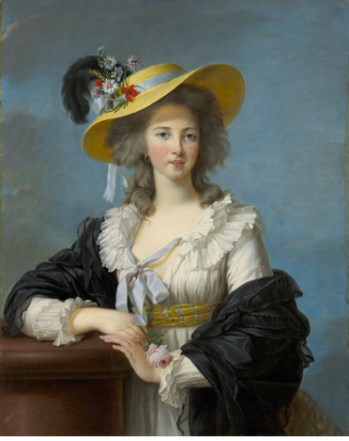Exhibition | French Paintings from the Wadsworth Atheneum
It’s interesting to see how this exhibition has been retitled in various venues: from Old Masters to Impressionists, to Old Masters to Monet, to Court to Café. The exhibition appeared in a fuller version at the Wadsworth Atheneum itself as Medieval to Monet: French Paintings, where it was accompanied by a full catalogue. -CH
◊ ◊ ◊ ◊ ◊
Press release (4 December 2012) from the Mississippi Museum of Art:
Old Masters to to Monet: Three Centuries of French Painting from the Wadsworth Atheneum
The Michele and Donald D’Amour Museum of Fine Arts, Springfield, MA, 13 December 2011 — 29 April 2012
Taft Museum of Art, Cincinnati, 18 May — 16 September 20122
Wadsworth Atheneum, Hartford, CT, 19 October 2012 — 27 January 2013 [expanded version of the exhibition]
Mississippi Museum of Art, Jackson, 23 March — 8 September 2013
Denver Art Museum, 27 October 2013 — 9 February 2014

Elisabeth-Louise Vigée Le Brun, The Duchesse de Polignac Wearing a Straw Hat, 1782 (Hartford, CT: Wadsworth Atheneum Museum of Art)
The Mississippi Museum of Art is pleased to present Old Masters to Monet: Three Centuries of French Painting from the Wadsworth Atheneum, on view from March 23 through September 8, 2013. It is the thirteenth presentation in The Annie Laurie Swaim Hearin Memorial Exhibition Series. Established in 1989 to honor the memory of Annie Laurie Swaim Hearin, one of the Museum’s most dedicated patrons and volunteers, the Hearin series showcases exhibitions of world-class art, attracting visitors to Jackson from across Mississippi, the Southeast, and beyond.
Old Masters to Monet features fifty masterpieces from the collection of the Wadsworth Atheneum in Hartford, Connecticut. The outstanding artworks provide a history of French painting, ranging from the seventeenth through the nineteenth centuries and into the beginning of the twentieth century and include religious and mythological subjects, portraits, landscapes, still lifes, and genre scenes.
The Wadsworth Atheneum is America’s oldest public art museum, founded in 1843, and has never presented a full-scale survey of its distinguished collection of French paintings. To honor the recent publication of its
collection catalogue, the Atheneum has launched a tour of fifty of these outstanding masterpieces. “The Mississippi Museum of Art is honored to be one of the select venues to host this important exhibition,” said Betsy Bradley, director of the Mississippi Museum of Art. “In keeping with our mission of engaging Mississippians in the visual arts, this exhibition provides a rare opportunity for our visitors to come face to face with some of the most historically valued French paintings held in any museum collection.”
The exhibition begins with the great seventeenth-century masters, Nicolas Poussin, Claude Lorrain, Simon Vouet, and Jacques Stella, all of whom spent time in Rome and whose work embodies Italianate ideas of beauty, classical sculpture, and ideal landscape. Poussin’s enormous Crucifixion, painted in 1646 for President Jacques-Auguste de Thou, and Lorrain’s Landscape with St. George and the Dragon, commissioned by Cardinal Fausto Poli in 1641, are among the most important French paintings residing in the United States.
The eighteenth-century works present a remarkably rich tapestry of life in France during the rococo age. There are several scenes and portraits of aristocrats, including the Portrait of the Duchesse de Polignac by the era’s leading painter of women, Madame Vigée-Lebrun. Genre scenes rendered during this period exhibit a decidedly risqué bent as well as humorous aspects of life, both of which are evident in paintings on view by Jean Baptiste Greuze, François Boucher, and Louis Leopold Boilly. A more serious approach is evidenced in Still Life by Jean Baptiste Simeon Chardin and in the charming family pictures by Nicolas-Bernard Lépicié and Nöel Hallé. The change in style brought about by the French Revolution is evident in the impressive composition designed by Jacques Louis David, and the creation of a new aristocracy is presented by the two brilliant paintings by Jean Auguste Dominique Ingres.
A series of diverse trends unfolds during the nineteenth century. There is the vigorous Romanticism of Théodore Géricault and Eugène Delacroix; pastoral and realistic landscapes by Jean Baptiste Camille Corot, Jules Dupré, Gustave Courbet, and Pierre-Etienne-Theodore Rousseau; the academicism of William Adolphe Bourguereau, Jehan Georges Vibert, and Henri Paul Motte, whose Trojan Horse of 1874 is the most recent French painting purchased by the Atheneum. In addition, there is the earthy realism of François Bonvin and Theodule Augustin Ribot. Portraiture is represented by the surprisingly early portrait of a young woman (Mademoiselle Henriette Ferre, ca. 1841) by Jean François Millet.
Perhaps the most exciting group of works in the exhibition is the selection of the Impressionists, and no picture better captures the essence of this popular school than Pierre-Auguste Renoir’s famous painting of his friend Claude Monet at work in the garden of their rented home at Argenteuil in 1873. In addition, there are two superb paintings by Monet himself – the 1870 Beach at Trouville – and the 1904 depiction of his Nymphéas (Water Lilies). Also included are fine examples by their colleagues Edouard Manet, Camille Pissarro, Alfred Sisley, Edgar Degas, and Paul Cézanne. The younger Post-Impressionistic generation, who pursued symbolist and expressionist means to achieve their ends, is represented here by Louis Anqutin’s seminal Avenue de Clichy, a view of a Parisian boulevard on a rainy evening. This painting had a profound effect on Vincent van Gogh, whose own powerful Self-Portrait of about 1887 is included. Finally there are the intimist painters: Paul Ranson, Edouard Vuillard, and Pierre Bonnard, all of whom focus on interiors.




























leave a comment